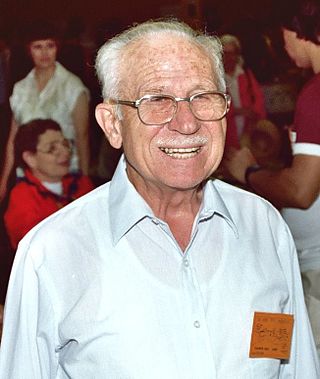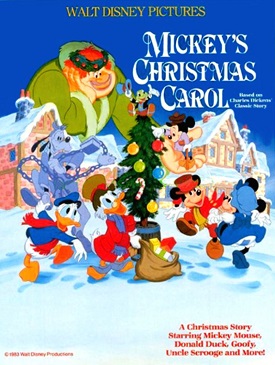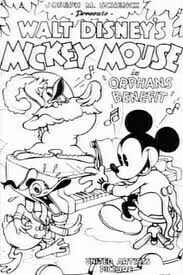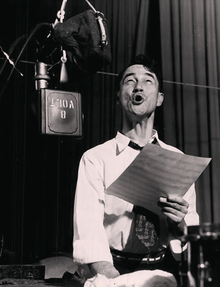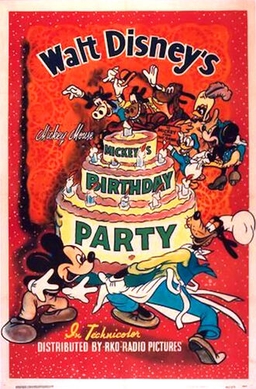Plot
Jiminy Cricket first appears inside a large plant in a large house, exploring and singing "I'm a Happy-go-Lucky Fellow", until he happens to stumble upon a doll, a teddy bear, and a record player with some records, one of which is Bongo, a musical romance story narrated by actress Dinah Shore. Jiminy decides to set up the record player to play the story of Bongo.
The story follows the adventures of a circus bear named Bongo who longs for freedom in the wild. Bongo is raised in captivity and is praised for his performances, but is poorly treated once he is off stage. As such, while traveling on a circus train, his natural instincts (the call of the wild) urge him to break free. As soon as he escapes and enters a forest, a day passes before his idealistic assessment of his new living situation has been emotionally shattered, and he experiences some hard conditions.
The next morning, however, he meets a female bear named Lulubelle. The two bears immediately fall in love, until Bongo soon faces a romantic rival in the bush. An enormously-shaped rogue bear named Lumpjaw. Bongo fails to interpret Lulubelle slapping him as a sign of affection, and when she accidentally slaps Lumpjaw, he claims her for himself, forcing all other bears into a celebration for the happy new couple. Bongo comes to understand the meaning of slapping one another among wild bears and returns to challenge Lumpjaw. He manages to outwit Lumpjaw for much of their fight until the two fall into a treacherous river and go over the waterfall. While Lumpjaw is presumably swept away and never to be seen again, Bongo's hat saves him from falling down, and he finally claims Lulubelle as his mate.
After the story is over, Jimminy starts to walk out. But then he notices a birthday invitation to Luana Patten. A party is taking place in the house across the way with Charlie McCarthy, Mortimer Snerd and Edgar Bergen. Excited, he exits the house out a window and hops over to the house across the way. He quiettly and obliviously attends the party while Luana, Charlie, Mortimer and Edgar party together. Edgar decides to tell a story to entertain them.
In a parody of "Jack and the Beanstalk", a jovial countryside land called Happy Valley, kept alive at all times by a singing golden Harp, is suddenly plagued by a severe drought and falls into turmoil and depression after the instrument is stolen from the castle by a mysterious figure. After weeks pass, there are only peasants remaining, the story then looks into three of them: Mickey, Donald, and Goofy. The trio have but just one loaf of bread and a single solitary bean to eat to share, but Donald, driven insane by his hunger, attempts to make a sandwich out of plates and silverware, before trying to kill the trio's pet cow with an axe. Mickey decides to sell the cow for money to buy food.
Goofy and Donald are excited about eating more food again until Mickey comes back and reveals that he sold the cow in exchange for a container of beans that are said to be magical. Thinking that Mickey had been conned, an angry Donald throws the beans down a hole in the floor. However, it turns out that the beans are truly magical as later that night, a gigantic beanstalk grows, taking the house with it.
The next morning, Mickey, Donald, and Goofy soon find themselves at the top of the beanstalk and in a magical kingdom of enormous scope, where they appear to be tiny compared to their surroundings. They eventually make their way to a huge castle, where they help themselves to a sumptuous feast. There, they stumble across the harp locked inside a small box, and she explains that she was kidnapped by a "wicked" giant. Immediately after, a giant named Willie enters, grunting angrily while simultaneously breaking into a happy song while demonstrating his powers of flight, invisibility, and shapeshifting.
As Willie prepares to eat lunch, he catches Mickey hiding in his sandwich after Mickey sneezes when Willie pours some chilli pepper onto the sandwich. Mickey then plays palm reader and gains the giant's trust. Willie offers to show off his powers, and Mickey, spotting a nearby fly-swatter, requests that he change himself into a fly. However, Willie suggests turning into a pink bunny instead, and as he does, he sees Mickey, Donald, and Goofy with the fly-swatter. Angered, Willie captures Donald and Goofy and locks them in the harp's chest.
Mickey is at a loss, but with the help of the musical harp, who begins singing Willie to sleep, he frees his friends and they make a break for it with the harp. However, Willie wakes up from his sleep and spots them, giving chase all the way to the beanstalk. Mickey stalls him long enough for Donald and Goofy to reach the bottom as they begin to saw down the beanstalk. Mickey arrives just in time to help his friends finish the job, and the giant, who was climbing down, falls to his supposed death.
Back at Edgar Bergen's home, he finishes his story, saying that with the return of the harp, Happy Valley returned to prosperity. He then cheers up Mortimer, who was mourning Willie's death. Just as Edgar says that Willie is a fictional character, the giant appears, having survived the fall, tearing the roof off Bergen's house. Willie inquires about Mickey's whereabouts, but Edgar faints in shock while Mortimer tells Willie goodnight. The movie then ends with Jiminy leaving the house and Willie stalking through Hollywood, searching for Mickey.
Production of the film
During the 1940s, Mickey and the Beanstalk and Bongo were originally going to be developed as two separate feature films.
In the late 1930s, Mickey's popularity fell behind Donald Duck, Goofy, Pluto, Max Fleischer's Popeye and Warner Bros.' Porky Pig. To boost his popularity, Disney and his artists created cartoons such as "Brave Little Tailor" and "The Sorcerer's Apprentice", the latter of which was later included in Fantasia (1940). In early 1940, during production on Fantasia, animators Bill Cottrell and T. Hee pitched the idea of a feature film based on Jack and the Beanstalk starring Mickey Mouse as Jack and with Donald Duck and Goofy as supporting characters. When they pitched it to Disney, he "burst out laughing with tears rolling down his cheeks with joy", as Cottrell and Hee later recalled. Disney enjoyed the pitch so much he invited other employees to listen to it. However, he said that, as much as he enjoyed the pitch of the film, the film itself would never go into production, because, as Disney claimed, they "murdered [his] characters". However, Cottrell and Hee were able to talk Disney into giving it the green-light and story development as The Legend of Happy Valley, which began production on May 2, 1940. [3]
The original treatment was more-or-less the same as what became the final film. However, there were a few deleted scenes. For example, there was a scene in which Mickey took the cow to market where he meets Honest John and Gideon from Pinocchio who con him into trading his cow for the "magic beans". [3] Another version had a scene where Mickey gave the cow to the Queen (played by Minnie Mouse) as a gift, and in return she gave him the magic beans. However, both scenes were cut when the story was trimmed for Fun and Fancy Free and the film does not explain how Mickey got the beans. [3]
Shortly after the rough animation on Dumbo was complete in May 1941, The Legend of Happy Valley went into production, using many of the same animation crew, although RKO doubted it would be a success. Since it was a simple, low-budget film, in six months, fifty minutes had been animated on Happy Valley. Then on October 27, 1941, due to the Disney animators' strike and World War II which had cut off Disney's foreign release market caused serious debts so Disney put The Legend of Happy Valley on hold.
Meanwhile, production was starting on Bongo, a film based on the short story written by Sinclair Lewis for Cosmopolitan magazine in 1930. It was suggested that Bongo could be a sequel to Dumbo and some of the cast from the 1941 film would appear as supporting characters; [3] however, the idea never fully materialized. In earlier drafts, Bongo had a chimpanzee as a friend and partner in his circus act. She was first called "Beverly" then "Chimpy", but the character was ultimately dropped when condensing the story. [3] Bongo and Chimpy also encountered two mischievous bear cubs who were dropped. [3] Originally, the designs for the characters were more realistic, but when paired for Fun and Fancy Free the designs were simplified and drawn more cartoony. [3] The script was nearly completed by December 8, 1941, the day after the attack on Pearl Harbor. [3]
On that same day, the United States military took control of the studio and commissioned Walt Disney Productions to produce instructional and war propaganda films in which pre-production work on Bongo and early versions of Alice in Wonderland and Peter Pan were shelved. [6] During and after the war, Disney stopped producing single narrative feature films due to costs and decided to make package films consisting of animated shorts to make feature films. He did this during the war on Saludos Amigos and The Three Caballeros and continued after the war until he had enough money to make a single narrative feature again.
Disney felt that since the animation of Bongo and The Legend of Happy Valley (which had been renamed Mickey and the Beanstalk) was not sophisticated enough to be a Disney animated feature film, the artists decided to include the story in a package film. Throughout the 1940s, Disney had suggested to pair Mickey and the Beanstalk with The Wind in the Willows (which was in production around this time) into a package film tentatively titled Two Fabulous Characters. Ultimately, Mickey and the Beanstalk was cut from Two Fabulous Characters and paired with Bongo instead. By late 1947, Wind in the Willows was paired with The Legend of Sleepy Hollow and re-titled The Adventures of Ichabod and Mr Toad .
Disney had provided the voice for Mickey Mouse since his debut in 1928, and Fun and Fancy Free was the last time he would voice the role regularly, as he no longer had the time or energy to do so. Disney recorded most of Mickey's dialogue in the spring and summer of 1941. Sound effects artist Jimmy MacDonald would become the character's new voice actor, starting in 1948. Disney, however, did reprise the role for the introduction to the original 1955–59 run of The Mickey Mouse Club . [10]
Celebrities Edgar Bergen and Dinah Shore introduced the segments in order to appeal to a mass audience. Jiminy Cricket from Pinocchio sings "I'm a Happy-Go-Lucky Fellow", a song written for and cut from Pinocchio before its release. [3]



